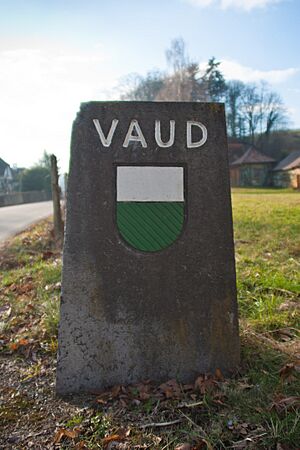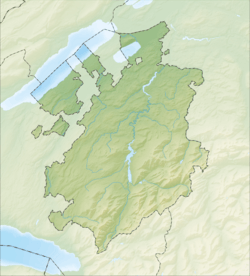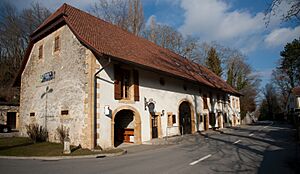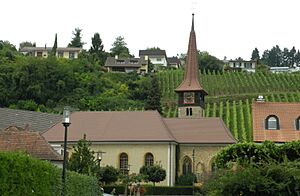Haut-Vully facts for kids
Quick facts for kids
Haut-Vully
|
||
|---|---|---|

Municipal administration building
|
||
|
||
| Country | Switzerland | |
| Canton | Fribourg | |
| District | See/Lac | |
| Area | ||
| • Total | 7.47 km2 (2.88 sq mi) | |
| Elevation | 434 m (1,424 ft) | |
| Population
(December 2020)
|
||
| • Total | 1,375 | |
| • Density | 184.07/km2 (476.7/sq mi) | |
| Postal code |
1787 Môtier
1789 Lugnorre |
|
| Surrounded by | Bas-Vully, Cudrefin (VD), Faoug (VD), Greng, Ins (BE), Meyriez, Mur (VD), Murten/Morat | |
Haut-Vully (pronounced 'Oh-Voo-lee') was a town in Switzerland. It was located in the canton of Fribourg. This area is known as the See/Lac district. Before 2016, Haut-Vully was its own municipality. On January 1, 2016, it joined with another town, Bas-Vully, to create a new municipality called Mont-Vully. For a long time, until 1977, it was officially called Vully-Le-Haut. Its old German name, Oberwistenlach, is not used much anymore.
Contents
History of Haut-Vully
Haut-Vully is a very old place. It was first mentioned in writings around the years 968-985. Back then, it was called Vuisliacense. Later, in 1453, its name was recorded as Vuilliez.
Geography and Landscape

Haut-Vully covered an area of about 7.6 square kilometers (2.9 square miles). A large part of this land, about 70%, was used for farming. This means people grew crops or raised animals there. About 13% of the land was covered by forests.
Another 13% of the area was settled, meaning it had buildings or roads. A small part, about 2.5%, was made up of rivers or lakes. The rest, less than 1%, was land that couldn't be used for farming or building.
The former town is located on the southwest side of Mont Vully. The northern edge of the area touches the Broye River, which flows into Lake Neuchatel. Haut-Vully included several villages like Môtier, Lugnorre, Joressant, and Mur. It also had a small hamlet called Guévaux.
Coat of Arms
The coat of arms for Haut-Vully has a special design. It is red, with two golden keys crossed like an 'X' at the top. In the middle, there is a silver shield with a golden border. Inside this small shield are five golden diamond shapes.
People and Population
In 2014, Haut-Vully had a population of 1,397 people. Over ten years, from 2000 to 2010, the number of people living there grew by about 25%. Most of this growth was because new people moved into the area.
Most people in Haut-Vully speak French. About 58% of the population speaks French as their main language. The second most common language is German, spoken by about 36% of the people. A smaller number of people speak Portuguese or Italian.
In 2000, about 22% of the population were children and teenagers (under 20 years old). Adults (20-64 years old) made up about 60% of the population. Seniors (over 64 years old) made up about 17%.
The chart below shows how the population of Haut-Vully has changed over many years:

Important Heritage Sites
Haut-Vully is home to several important historical buildings. The House De W. J. Merz, the Gatschet House, and the Les Rondas House are all listed as heritage sites of national importance. This means they are very special and protected. The entire village of Môtier is also recognized as an important Swiss heritage site.
World Heritage Site
Haut-Vully is also part of a UNESCO World Heritage Site! It has prehistoric pile-dwelling settlements called Môtier I. These are ancient villages built on stilts, often over water or marshy land. They are part of the "Prehistoric Pile dwellings around the Alps" World Heritage Site.
The Môtier I site has not been fully explored yet. It seems to be a settlement from the Neolithic period, which was a very long time ago. This is known because stone axes were found there. The site was discovered in 1860. Today, the entire site is on dry land and covered by earth.
Economy and Jobs
In 2010, the unemployment rate in Haut-Vully was low, at 2%. This means most people who wanted to work had jobs.
The economy of Haut-Vully involved three main types of jobs:
- Primary sector: This includes jobs that get raw materials from nature, like farming or fishing. In 2008, about 106 people worked in this sector, mostly in agriculture.
- Secondary sector: These jobs involve making things, like in factories or construction. About 59 people worked in this sector, with jobs in manufacturing and building.
- Tertiary sector: This includes jobs that provide services, like working in shops, hotels, or offices. About 138 people worked in this sector.
Many people who lived in Haut-Vully traveled to other towns for work. In 2000, about 395 people left the town for their jobs, while only 68 people came into the town to work. Most people used private cars to get to work.
Religion
According to the 2000 census, most people in Haut-Vully belonged to one of two main Christian groups. About 22% were Roman Catholic. A larger group, about 60%, belonged to the Swiss Reformed Church. Some people belonged to other Christian churches or had no religious affiliation.
Education
In Haut-Vully, many adults have completed higher levels of education. About 33% of the population finished non-mandatory upper secondary education. This is like high school. Another 22% went on to complete even higher education, such as university or a specialized college.
The school system in the Canton of Fribourg works like this:
- First, there is one year of optional Kindergarten.
- Then, students go to Primary school for six years.
- After that, there are three years of lower Secondary school. Students are grouped based on their abilities.
- Finally, students can choose to attend an upper Secondary school for three or four years. This can be a gymnasium (which prepares students for university) or a vocational program (which teaches job skills).
- After upper Secondary, students can go to a Tertiary school (like a university) or start an apprenticeship.
In the 2010-2011 school year, Haut-Vully had 87 students in 5 classes. While some students went to school in Haut-Vully, many also attended schools in nearby towns.
See also
 In Spanish: Haut-Vully para niños
In Spanish: Haut-Vully para niños








